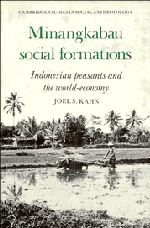Book contents
- Frontmatter
- Contents
- Lists of maps, figures and tables
- Preface
- Map
- 1 Introduction
- 2 The internal and the external in a Minangkabau village: an introduction to the world of the concrete
- 3 Adat, kinship and marriage: the constitution of the subsistence community
- 4 Agriculture and subsistence: the reproduction of the subsistence community
- 5 Commodity production in the village economy: the case of blacksmithing
- 6 Occupation, class and the peasant economy
- 7 The structure of petty commodity production
- 8 Mercantilism and the evolution of ‘traditional’ society
- 9 The emergence of petty commodity production
- 10 Conclusions: The concept of a neo-colonial social formation
- Bibliography
- Glossary of Minangkabau terms
- Index
- CAMBRIDGE STUDIES IN SOCIAL ANTHROPOLOGY
5 - Commodity production in the village economy: the case of blacksmithing
Published online by Cambridge University Press: 29 September 2009
- Frontmatter
- Contents
- Lists of maps, figures and tables
- Preface
- Map
- 1 Introduction
- 2 The internal and the external in a Minangkabau village: an introduction to the world of the concrete
- 3 Adat, kinship and marriage: the constitution of the subsistence community
- 4 Agriculture and subsistence: the reproduction of the subsistence community
- 5 Commodity production in the village economy: the case of blacksmithing
- 6 Occupation, class and the peasant economy
- 7 The structure of petty commodity production
- 8 Mercantilism and the evolution of ‘traditional’ society
- 9 The emergence of petty commodity production
- 10 Conclusions: The concept of a neo-colonial social formation
- Bibliography
- Glossary of Minangkabau terms
- Index
- CAMBRIDGE STUDIES IN SOCIAL ANTHROPOLOGY
Summary
Since the people of Limo Suku grow rice exclusively for their own consumption, and only a small proportion of that, they, like other peasants, rely on production of commodities specifically for the market to provide themselves with the rest of the food and the other goods and services they need. Clothing, furniture, building materials, tools, lamps, stoves, bicycles and the like are all considered necessary to life. The result is a national and international division of labour, under which individual Sungai Puar peasants produce a number of commodities. In exchange for their commodities they receive money – all market transactions are conducted via the Indonesian rupiah – which in turn they use to purchase other commodities produced in other parts of Sumatra, other Indonesian islands and other parts of the world. Just as some of the goods on sale in the Bukit Tinggi market are locally produced and some are produced in other parts of the world, so some of the commodities produced in West Sumatra are brought and consumed locally and some are aimed at the world market. Rubber, coffee, tea and spices produced by Minangkabau peasants are not just sold within the province, but find their way to markets in Europe, Japan or America. In turn a large proportion of the bicycles, cloth and other manufactured goods bought by villagers come from outside the national boundaries.
There is no village in West Sumatra independent of this international economic system.
- Type
- Chapter
- Information
- Minangkabau Social FormationsIndonesian Peasants and the World-Economy, pp. 75 - 102Publisher: Cambridge University PressPrint publication year: 1980



